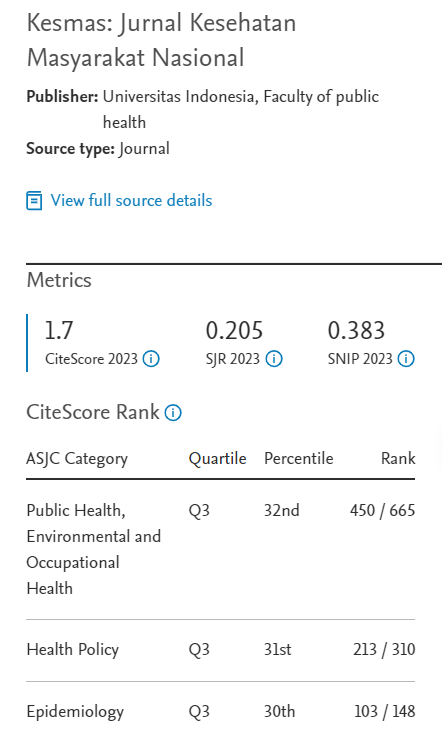Abstract
Beberapa tahun terakhir angka obesitas di Indonesia cenderung meningkat. Obesitas terjadi akibat ketidakseimbangan antara asupan dan output energi dalam jangka waktu cukup lama. Tujuan penelitian ini adalah untuk mengetahui faktor risiko kejadian obesitas pada pekerja on shore di perusahaan minyak dan gas. Desain penelitian ini adalah studi cross sectional. Sampel yang diteliti adalah seluruh pekerja on shore (laki-laki maupun perempuan) berusia 35 – 55 tahun yang sesuai dan memenuhi kriteria inklusi dan ekslusi yang telah ditetapkan (n = 378). Hasil penelitian menunjukkan bahwa prevalensi obesitas (IMT ³ 25 kg/m2) pada pekerja on-shore sebesar 49,5%. Variabel umur, tingkat pendidikan, status pegawai, asupan energi, karbohidrat, dan serat memiliki hubungan signifikan dengan kejadian obesitas (nilai p < 0,05). Faktor yang paling dominan berhubungan dengan kejadian obesitas adalah tingkat pendidikan (OR = 2,85; 95%CI = 1,240 – 6,502). Tingginya prevalensi obesitas pada pekerja memerlukan perhatian yang lebih serius dari pihak perusahaan dalam menanggulangi masalah obesitas melalui upaya peningkatan program komunikasi, informasi, dan edukasi gizi yang lebih terarah dan terprogram serta perlu dilakukan sosialisasi untuk memantau berat badan dan lingkar pinggang-panggul secara rutin untuk mencegah timbulnya penyakit jantung koroner.
In the last few years the incidence of obesity in Indonesia tends to increase. Obesity is caused by an imbalance between energy intake and output in a long term. The purpose of this study was to identify risk factors in the incidence of obesity of the workers on-shore oil and gas companies. This research designed by cross sectional study.The subject of this research was on shore workers of oil and gas company (male and female) aged 35 – 55 years old in East Kalimantan and were eligible for inclusion and exclusion criteria (n = 378). The results showed that the prevalence of obesity of on-shore workers was as high as 49.5% (BMI ³ 25 kg/m2). Age, level of education, employement status, energy, carbohydrate, and fiber intake were associated with obesity (p value < 0,05). The most dominant factor associated with obesity was level of education (OR = 2,85; 95%CI = 1,240 - 6,502). The high prevalence of obesity in the workers need more serious attention from the company in overcoming the problem of obesity, by enhancing the EIC program with more focused and sustainable, and need to socialize monitoring of body weight and waist-hip circumference regularly to prevent coronary heart disease.
References
- Jakicic JM, Otto AD. Physical activity considerations for the treatment and prevention of obesity. Am J Clin Nutr. 2005; 82 (suppl): 226S-9S.
- Aekplakorn W. Trends in obesity and associations with education and urban or rural residence in Thailand. Asia Pacific J Clin Nutr. 2007; 15: 3113-21.
- National Institutes of Health. Obesity: the prevention, identification, assessment, and management of overweight and obesity in adults and children. National Institute for Health and Clinical Excellence, National Collaborating Centre for Primary Care; 2006.
- Blackburn GL, Walker WA. Science-based solutions to obesity: what are the roles of academia, government, industry, and health care? Am J Clin Nutr. 2005; 82 (suppl): 207S-10S.
- Kementerian Kesehatan Republik Indonesia. Survei kesehatan rumah tangga 2004. Jakarta: Kementerian Kesehatan Republik Indonesia; 2005.
- Kementerian Kesehatan Republik Indonesia. Riset kesehatan dasar. Jakarta: Kementerian Kesehatan Republik Indonesia; 2007.
- World Health Organization Expert Consultation. Appropriate body mass index for asian populations and its implications for policy and intervention strategies. Lancet; 2004. p.157-63.
- Kementerian Kesehatan Republik Indonesia. Profil kesehatan Indonesia 2004. Jakarta: Kementerian Kesehatan Republik Indonesia; 2006.
- Hasanah N. Faktor-faktor yang berhubungan dengan penyakit jantung koroner pada karyawan Vico Indonesia Muara Badak, Kalimantan Timur [skripsi]. Depok: Fakultas Kesehatan Masyarakat Universitas Indonesia; 2006.
- Heath GW, Robert HW, Juneal S, Bruce EL. Community-based exercise and weight control: diabetes risk reduction and glycemic control in Zuni Indians. Am J Clin Nutr. 1991; 53: 1642S-6S.
- Pradono J, Hapsari D, Soematri S. Faktor berisiko yang mempengaruhi penyakit tidak menular di Jawa dan Bali. Buletin Penelitian Kesehatan. 2003; 31 (3): 166-76.
- Treacy J. Obesity. The Report of the National Taskforce on Obesity. 2005. Available from: http://www.ireland.com/newspaper/special/2005/obesity/report.pdf.
- Soerjodibroto W. Asia Pasific menu pattern in relation to lipid abnormalities: an Indonesia persperctive. Medical Journal of Indonesia. 2004; 13: 252-7.
- Law C. Obesity and health inequalities. The International Association For the Study of Obesity. 2006 [8 (suppl. 1): 19-22]. Available from: http://www.blackwell-synergy.com.
- Parkes KR. Physical activity and self-rated health: interactive effects of activity in work and leisure domains. British Journal of Health Psychology. 2006; 11 (3): 533-50.
- Hu FB, Manson JE, Willett WC. Types of dietary fat and risk of coronary heart disease: a critical review. J Am Coll Nutr. 2001; 20 (1): 5-19.
- Perhimpunan Dokter Spesialis Kardiovaskular Indonesia Yayasan Jantung Indonesia. Pedoman makanan untuk kesehatan jantung Indonesia. Jakarta; Yayasan Jantung Indonesia: 2002.
- Jebb SA. Dietary determinants of obesity. The International Association For the Study of Obesity. 2007; 8 (suppl. 1): 93-7.
Recommended Citation
Christina D , Sartika RD .
Obesitas pada Pekerja Minyak dan Gas.
Kesmas.
2011;
6(3):
-
DOI: 10.21109/kesmas.v6i3.100
Available at:
https://scholarhub.ui.ac.id/kesmas/vol6/iss3/2







